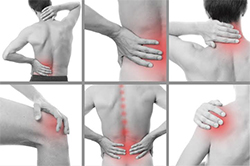
The International Association for the Study of Pain (IASP) classified pain according to specific characteristics:
Pain is often classified by body location. Two overlapping schemes relate the pain to the specific anatomy and/or body system thought to be involved. The anatomic pain classification system identifies sites of pain as viewed from a regional perspective (eg, lower back pain, headache, pelvic pain). In contrast, the body system pain classification method focuses on classical body systems (eg, musculoskeletal, neurologic, vascular).
Pain that lasts a long time is called chronic, and pain that resolves quickly is called acute. Traditionally, the distinction between acute and chronic pain has relied upon an arbitrary interval of time from onset; the two most commonly used markers being 3 months and 6 months since the onset of pain.
Acute Pain
Acute pain occurs for brief periods of time and is associated with temporary disorders. However, it is always an alarm signal that something may be wrong.
Chronic Pain
Chronic pain is continuous and recurrent. It is associated with chronic diseases and is one of their symptoms.
Pain intensity not only depends on the type of stimulus that caused it, but also on the subjective perception of the pain. It is broadly classified into:
- Mild Pain
- Moderate Pain
- Severe Pain
Nociceptive Pain
Pain that arises from actual or threatened damage to non-neural tissue and is due to the activation of nociceptors. The most common categories being "thermal" (e.g. heat or cold), "mechanical" (e.g. crushing, tearing, shearing, etc.) and "chemical" (e.g. iodine in a cut, chili powder in the eyes).
This term is designed to contrast with neuropathic pain. The term is used to describe pain occurring with a normally functioning somatosensory nervous system to contrast with the abnormal function seen in neuropathic pain.
Neuropathic Pain
Pain caused by a lesion or disease of the somatosensory nervous system whichis involved in bodily feelings. Peripheral neuropathic pain is often described as "burning", "tingling", "electrical", "stabbing", or "pins and needles".
Breakthrough Pain
Breakthrough pain is transitory acute pain that comes on suddenly and is not alleviated by the patient's normal pain management. In essence, it means the patient needs more medication to cover the chronic pain and another drug for the breakthrough pain. Breakthrough pain occurs when you're doing something that triggers extra pain, like getting up after knee surgery. Sometimes breakthrough pain just occurs, without any obvious trigger. Breakthrough pain may be different for each person, and the person usually cannot tell when it will happen. As a rule, it comes on quickly, lasts as long as an hour, and feels much like persistent pain except that it’s more severe or intense. It may happen many times a day, even when the chronic pain is generally controlled by the regular pain medicine.
Cancer Pain
Pain is most often caused by the cancer itself. But pain can also be caused by the treatment or the tests done to diagnose cancer. You may also have pain that has nothing to do with the cancer or its treatment. Like anyone, you can get headaches, muscle strains, and other aches and pains.
- Pain from the cancer
Whether you have pain and the amount of pain you have depends on the type of cancer, its stage (extent), and your pain threshold (tolerance for pain). Most of the pain occurs when a tumor presses on bones, nerves, or body organs. People with advanced cancer are more likely to have pain.- Spinal cord compression
When a tumor spreads to the spine, it can press on the spinal cord. This is called spinal cord compression. The first sign of compression is usually back and/or neck pain, sometimes with pain, numbness, or weakness in an arm or leg. If you have this pain, get help right away. This compression must be treated quickly to keep you from losing control of your bladder or bowel or being paralyzed. Your doctor can treat the cause of the pain and also give you medicine to relieve the pain. - Bone pain
This type of pain can happen when cancer spreads to the bones. Treatment may be aimed at controlling the cancer, or it can focus on protecting the affected bones. You may still need pain medicines for treating the pain.
- Spinal cord compression
- Pain from Procedures and Surgery
Some tests used to diagnose cancer and see how well treatment is working are painful. If you and your doctors agree that such a procedure is needed, concern about pain should not keep you from having it done. Any pain you have during and after the procedure can usually be relieved.- Surgical Pain
Surgery is often used to treat cancers that grow as solid tumors, but other treatments such as radiation or chemotherapy may also be given. Depending on the kind of surgery you have, some amount of pain is usually expected. Pain due to surgery can last from a few days to a few weeks, depending on the type of surgery. - Phantom Pain
Phantom pain is pain felt in a part of the body that has been lost or from which the brain no longer receives signals. This is a longer-lasting effect of surgery, beyond the usual surgical pain. If you’ve had an arm, leg, or even a breast removed, you may still feel pain or other unusual or unpleasant feelings that seem to be coming from the absent (phantom) body part.
- Surgical Pain
- Pain from other Cancer Treatments
Some of the side effects that occur with chemotherapy and radiation treatments may cause pain for some people. Pain can even cause some people to stop treatment if it’s not managed. Some examples of pain caused by treatment are:- Peripheral neuropathy (PN)
This condition refers to pain, burning, tingling, numbness, weakness, clumsiness, trouble walking, or unusual sensations in the hands and arms or legs and feet. Peripheral neuropathy can be caused by certain types of chemotherapy, though vitamin deficiencies, cancer, and other problems can also cause it. - Mouth sores (stomatitis or mucositis)
Chemotherapy can cause sores and pain in the mouth and throat. The pain can be bad enough that people have trouble eating, drinking, and even talking. - Radiation mucositis and other radiation injuries
Pain from external beam radiation depends on the part of the body that’s treated. It can cause skin burns, mucositis (mouth sores), and scarring – all of which can result in pain. The throat, intestine, and bladder are also prone to radiation injury, and you may have pain if these areas are treated.
- Peripheral neuropathy (PN)
